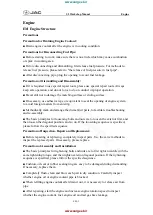
Active Blind Spot Assist monitors the area up
to 3.0 m behind your vehicle and directly next
to your vehicle, as shown in the diagram.
The detection of vehicles may be impaired in
the case of:
R
dirt on the sensors or the sensors are
obscured
R
poor visibility, e.g. due to rain, snow or
spray
Vehicles in the monitoring range will then be
indicated late or not at all.
Active Blind Spot Assist may not detect nar-
row vehicles, such as motorcycles or bicy-
cles, or may only detect them too late.
If the lanes are narrow, vehicles driving in the
lane beyond the lane next to your vehicle may
be indicated, especially if the vehicles are not
driving in the middle of their lane. This may
be the case if there are vehicles at the edge
of their lane.
Due to the nature of the system:
R
warnings may be issued in error when driv-
ing close to crash barriers or similar solid
lane borders
R
warnings may be interrupted when driving
alongside long vehicles, for example lor-
ries, for a prolonged time.
Indicator and warning display
:
Yellow indicator lamp/red warning lamp
Active Blind Spot Assist is not active at
speeds below approximately 30 km/h. Vehi-
cles in the monitoring range are then not indi-
cated.
If Active Blind Spot Assist is switched on,
indicator lamp
:
in the exterior mirrors lights
up yellow up to a speed of 30 km/h. At
speeds above 30 km/h, the indicator lamp
goes out and Active Blind Spot Assist is
operational.
If a vehicle is detected within the monitoring
range of Blind Spot Assist at speeds above
30 km/h, warning lamp
:
on the corre-
sponding side lights up red. A warning is
always issued when a vehicle enters the blind
spot monitoring range from behind or from
the side. When you overtake a vehicle, the
warning only occurs if the difference in speed
is less than 12 km/h.
The yellow indicator lamp goes out if reverse
gear is engaged. Active Blind Spot Assist is
then no longer active.
The brightness of the indicator/warning
lamps is adjusted automatically according to
the ambient light.
Visual and acoustic collision warning
If you switch on the turn signals to change
lanes and a vehicle is detected in the side
monitoring range, you receive a visual and
acoustic collision warning. You then hear a
double warning tone and red warning
lamp
:
flashes. If the turn signal remains on,
detected vehicles are indicated by the flash-
ing of red warning lamp
:
. There are no fur-
ther warning tones.
Course-correcting brake application
G
WARNING
A course-correcting brake application cannot
always prevent a collision. There is a risk of
an accident.
Always steer, brake or accelerate yourself,
especially if Active Blind Spot Assist warns
you or makes a course-correcting brake appli-
cation. Always maintain a safe distance at the
sides.
Driving systems
255
Driving and parking
Z
Summary of Contents for E 180
Page 1: ...E Class Saloon and Estate Owner s Manual Nur für internen Gebrauch For internal use only ...
Page 4: ......
Page 30: ...28 ...
Page 136: ...134 ...
Page 156: ...154 ...
Page 331: ...Useful information 330 Stowage areas 330 Features 348 329 Stowing and features ...
Page 364: ...362 ...
Page 365: ...Useful information 364 Engine compartment 364 Service 370 Care 371 363 Maintenance and care ...
Page 382: ...380 ...
Page 404: ...402 ...
Page 466: ...464 ...
Page 488: ...486 ...
Page 489: ...487 ...
Page 490: ...488 ...
















































